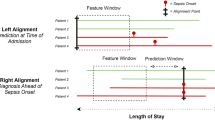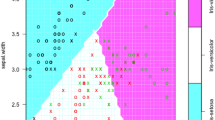Abstract
Endovascular aneurysm repair (EVAR) is an advanced minimally invasive surgical technology that is helpful for reducing patients’ recovery time, postoperative morbidity and mortality. This study proposes an ensemble model to predict postoperative morbidity after EVAR. The ensemble model was developed using a training set of consecutive patients who underwent EVAR between 2000 and 2009. All data required for prediction modeling, including patient demographics, preoperative, co-morbidities, and complication as outcome variables, was collected prospectively and entered into a clinical database. A discretization approach was used to categorize numerical values into informative feature space. Then, the Bayesian network (BN), artificial neural network (ANN), and support vector machine (SVM) were adopted as base models, and stacking combined multiple models. The research outcomes consisted of an ensemble model to predict postoperative morbidity after EVAR, the occurrence of postoperative complications prospectively recorded, and the causal effect knowledge by BNs with Markov blanket concept.




Similar content being viewed by others
References
Bush, R. L., Johnson, M. L., Hedayati, N., Henderson, W. G., Lin, P. H., and Lumsden, A. B., Performance of endovascular aortic aneurysm repair in high-risk patients: Results from the veterans affairs national surgical quality improvement program. J. Vasc. Surg. 45(2):227–235, 2007.
Barnes, M., Boult, M., Maddern, G., and Fitridge, R., A model to predict outcomes for Endovascular aneurysm repair using preoperative variables. Eur. J. Vasc. Endovasc. Surg. 35:571–579, 2008.
Bohm, N., Wales, L., Dunckley, M., Morgan, R., Loftus, I., and Thompson, M., Objective risk-scoring systems for repair of abdominal aortic aneurysms: applicability in Endovascular repair. Eur. J. Vasc. Endovasc. Surg. 36:172–177, 2008.
Stijn, C. W., Wouters, L. N., Freek, W. A. V., and Rene, M. H. J. B., Preoperative prediction of early mortality and morbidity in coronary bypass surgery. Cardiovasc. Surg. 10:500–505, 2002.
Roques, F., Michel, P., Goldstone, A. R., and Nashef, S. A., The logistic EuroSCORE. Eur. Heart J. 24:1–2, 2003.
Bellazzi, R., and Zupan, B., Predictive data mining in clinical medicine: Current issues and guidelines. Int. J. Med. Inform. 77:81–97, 2008.
Polikar, R., Ensemble based systems in decision making. IEEE Circuits Syst. Mag. 6(3):21–45, 2006.
Verduijn, M., Peek, N., Rosseel, P. M. J., de Jonge, E., and de Mol, B. A. J. M., Prognostic Bayesian networks I: Rationale, learning procedure, and clinical use. J. Biomed. Inform. 40:609–618, 2007.
Verduijn, M., Peek, N., Rosseel, P. M. J., de Jonge, E., and de Mol, B. A. J. M., Prognostic Bayesian networks II: An application in the domain of cardiac surgery. J. Biomed. Inform. 40:619–630, 2007.
Lin, J.-H., and Haug, J., Exploiting missing clinical data in Bayesian network modeling for predicting medical problems. J. Biomed. Inform. 41:1–14, 2008.
Rowan, M., Ryan, T., Hegarty, F., and O’Hare, N., The use of artificial neural networks to stratify the length of stay of cardiac patients based on preoperative and initial postoperative factors. Artif. Intell. Med. 40:211–221, 2007.
Lisboa, P. J., and Taktak, A. F. G., The use of artificial neural networks in decision support in cancer: A systematic review. Neural Netw. 19:408–415, 2006.
Dokur, Z., A unified framework for image compression and segmentation by using an incremental neural network. Expert Syst. Appl. 34:611–619, 2008.
Santos-García, G., Varela, G., Novoa, N., and Jiménez, M. F., Prediction of postoperative morbidity after lung resection using an artificial neural network ensemble. Artif. Intell. Med. 30:61–69, 2004.
Eom, J.-H., Kim, S.-C., and Zhang, B.-T., AptaCDSS-E: A classifier ensemble-based clinical decision support system for cardiovascular disease level prediction. Expert Syst. Appl. 34:2465–2479, 2008.
Polat, K., and Güne, S., Breast cancer diagnosis using least square support vector machine. Digital Signal Process. 17:694–701, 2007.
Choi, S., Detection of valvular heart disorders using wavelet packet decomposition and support vector machine. Expert Syst. Appl. 35:1679–1687, 2008.
Babaoĝlu, I., Fındık, O., and Bayrak, M., Effects of principle component analysis on assessment of coronary artery diseases using support vector machine. Expert Syst. Appl. 37(3):2182–2185, 2010.
Srikant, R., and Agrawal. R., Mining quantitative association rules in large relational tables. In Proceedings of ACM SIGMOD, 1996.
Fayyad, U. M. and Irani, K. B., Multi-interval discretization of continuous-valued attributes for classification learning, in Proceedings of the 13th international joint conference on artificial intelligence, Machine Learning. 1993, Morgan Kaufmann: Chambery, France. p. 1022–1027.
Dougherty, J., Kohavi, R., and Sahami, M., Supervised and unsupervised discretization of continuous features. In: Prieditis, A., and Russell, S. (Eds.), Proceedings of the 12th International conference on machine learning. Morgan Kaufmann, San Francisco, pp. 194–202, 1995.
Guyon, I., and Elisseeff, A., An introduction to variable and feature selection. J. Mach. Learn. Res. 3:1157–1182, 2003.
Hall, M. A., and Holmes, G., Benchmarking attribute selection techniques for discrete class data mining. IEEE Trans. Knowl. Data Eng. 15:1–16, 2003.
Seewald, A., How to make stacking better and faster while also taking care of an unknown weakness, in Proceedings of the 19th International Conference on Machine Learning. 2002. p. 554–561.
Kittler, J., Hatef, M., Duin, R. W., and Matas, J., On combining classifiers. IEEE Trans. Pattern Anal. Mach. Intell. 20:226–239, 1998.
Witten, I. H., and Frank, E., Data mining: Practical machine learning tools and techniques. Morgan Kaufmann Publishers, Boston, 2005.
Quinlan, J. R., Comparing connectionist and symbolic learning methods, in in Computational Learning Theory and Natural Learning Systems VOL. 1 1994, MIT Press: Cambridge, Mass, USA.
Caruana, R., and Niculescu-Mizil, A., An empirical comparison of supervised learning algorithms, in Proceedings of the 23 rd International Conference on Machine Learning. 2006. p. 161–168.
Hruschka, E. R., and Ebecken, N. F. F., Towards efficient variables ordering for Bayesian networks classifier. Data Knowl. Eng. 63(2):258–269, 2007.
Lin, J. H., and Haug, P. J., Exploiting missing clinical data in Bayesian network modeling for predicting medical problems. J. Biomed. Inform. 41:1–14, 2008.
Lauria, E. J. M., and Duchessi, P. J., A methodology for developing Bayesian networks: An application to information technology (IT) implementation. Eur. J. Oper. Res. 179(1):234–252, 2007.
Castelo, R., Feelders, A. J., and Siebes, A., MAMBO: Discovering association rules based on conditional independencies. In: Hoffmann F., et al. (Eds) ,Proceedings of the 4th international conference on advances in intelligent data analysis. Springer-Verlag, 2001, pp 289–298.
Jaroszewicz, S., and Simovici, D. A., Interestingness of frequent itemsets using Bayesian networks as background knowledge, in Proceedings of the 10th ACM SIGKDD international conference on Knowledge discovery and data mining 2004, ACM: Seattle, Washington, USA. pp 178–186.
Fauré, C., Delprat, S., Boulicaut, J.-F., and Mille, A., Iterative Bayesian network implementation by using annotated association rules. in Proceedings of the 15th international conference on knowledge engineering and knowledge management. 2006, Springer: Podebrady. pp 326–333.
Cheng, J., Greiner, R., Kelly, J., Bell, D. A., and Liu, W., Learning Bayesian networks from data: an information-theory based approach. Artif. Intell. J. 137:43–90, 2002.
Bai, X., Padman, R., Ramsey, J., and Spirtes, P., Tabu search-enhanced graphical models for classification in high dimensions. Informs. J. Comput. 20:423–437, 2008.
Acknowledgement
This research was partially supported by National Science Council of Taiwan (NSC99-2410-H-227-002-MY2).
Author information
Authors and Affiliations
Corresponding author
Rights and permissions
About this article
Cite this article
Hsieh, NC., Hung, LP., Shih, CC. et al. Intelligent Postoperative Morbidity Prediction of Heart Disease Using Artificial Intelligence Techniques. J Med Syst 36, 1809–1820 (2012). https://doi.org/10.1007/s10916-010-9640-7
Received:
Accepted:
Published:
Issue Date:
DOI: https://doi.org/10.1007/s10916-010-9640-7




